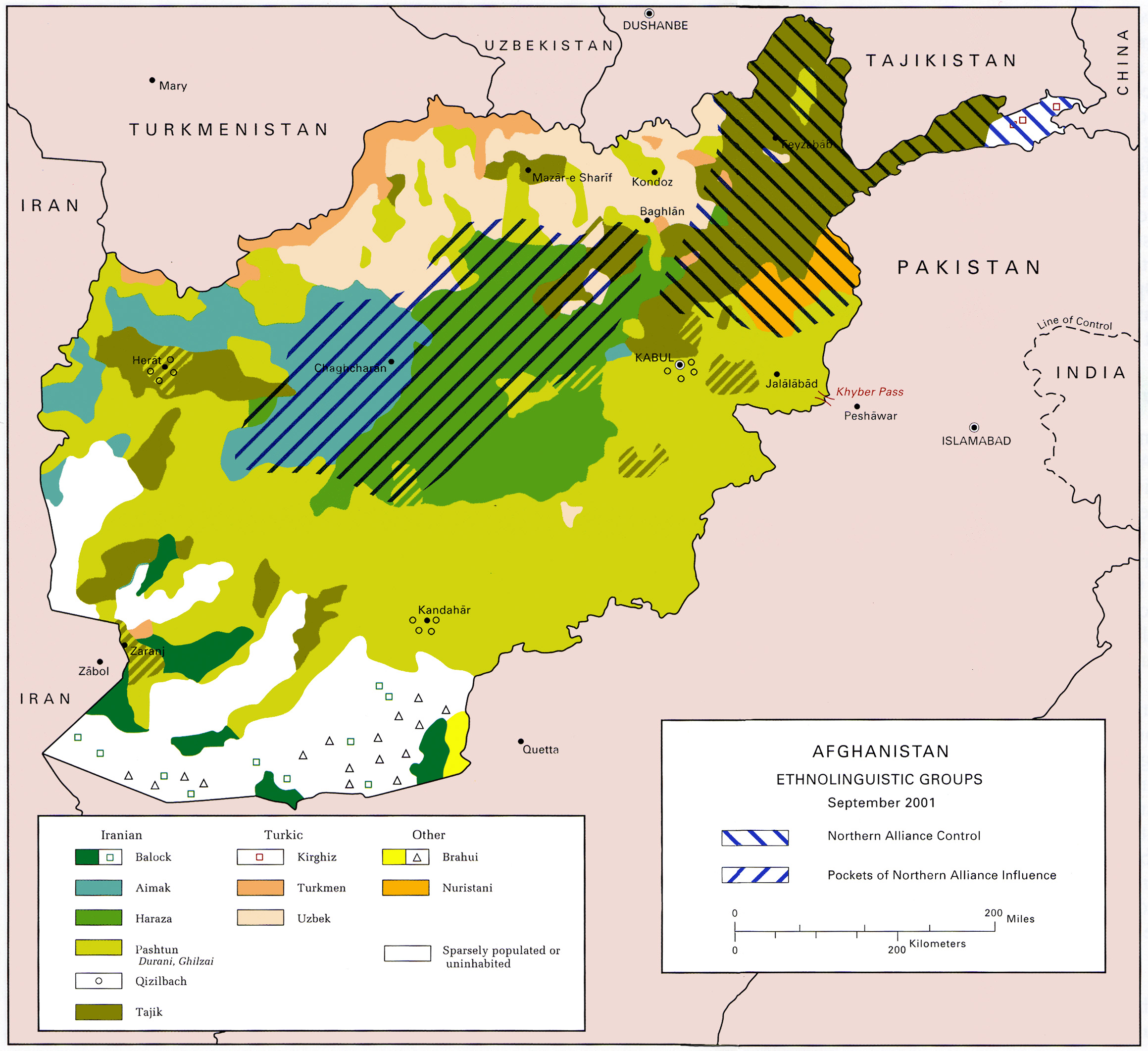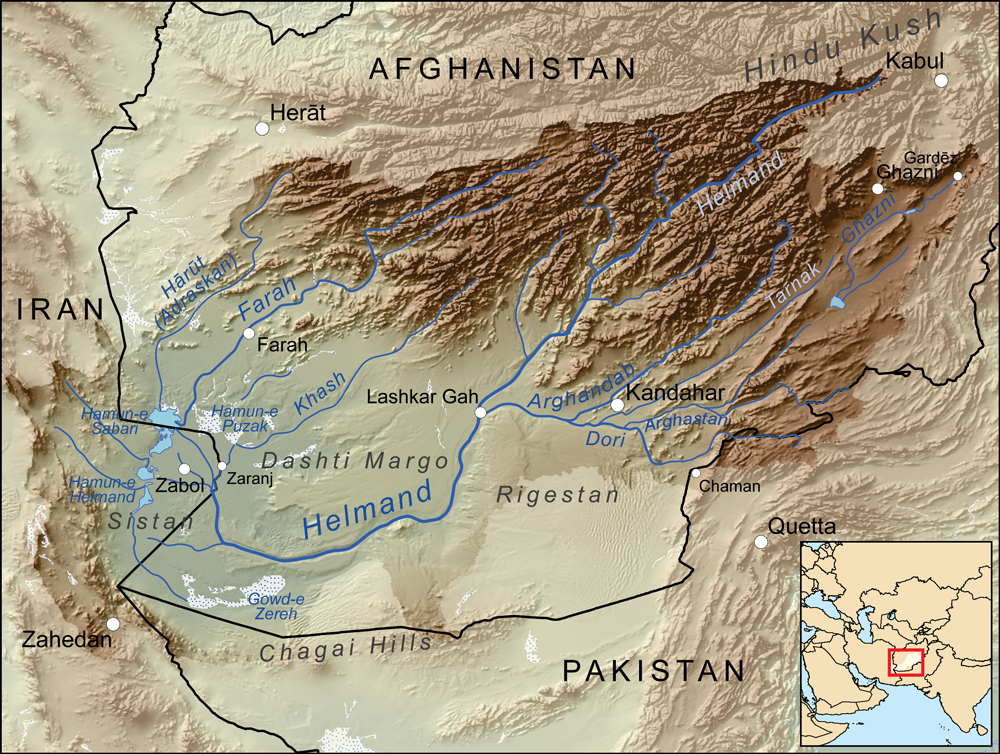|
Arghistan River
The Arghistan or Arghastan is a river in southern Afghanistan. It flows through Arghistan District and the provinces of Zabul and Kandahar. It is a tributary of the Dori River, a sub-tributary of the Helmand River. It flows for and has a basin area of . Geography The river rises in south-eastern Afghanistan, in the province of Zabul, near the border with Pakistan. Shortly after its start, the Arghastan takes a west-southwest course. It joins the Dori on the right bank, about south-west (downstream) of Kandahar. In its lower course, its waters are widely used to irrigate the oases of Kandahar, and its flow is greatly reduced. The average annual flow or module of the river is near the town of Kandahar.USGS Water Resources (1977) The Lora River (not to be confused with the Dori River, also known as the Lora River in its upper reaches) is a tributary from the northeast with its headwaters near Ab-i Istada Ab-i Istada ("standing water") is an endorheic salt lake in the Nawa D ... [...More Info...] [...Related Items...] OR: [Wikipedia] [Google] [Baidu] |
Afghanistan
Afghanistan, officially the Islamic Emirate of Afghanistan, is a landlocked country located at the crossroads of Central Asia and South Asia. It is bordered by Pakistan to the Durand Line, east and south, Iran to the Afghanistan–Iran border, west, Turkmenistan to the Afghanistan–Turkmenistan border, northwest, Uzbekistan to the Afghanistan–Uzbekistan border, north, Tajikistan to the Afghanistan–Tajikistan border, northeast, and China to the Afghanistan–China border, northeast and east. Occupying of land, the country is predominantly mountainous with plains Afghan Turkestan, in the north and Sistan Basin, the southwest, which are separated by the Hindu Kush mountain range. Kabul is the country's capital and largest city. Demographics of Afghanistan, Afghanistan's population is estimated to be between 36 and 50 million. Ancient history of Afghanistan, Human habitation in Afghanistan dates to the Middle Paleolithic era. Popularly referred to as the graveyard of empire ... [...More Info...] [...Related Items...] OR: [Wikipedia] [Google] [Baidu] |
Arghistan District
The Arghistan District (, ) is a district in the northeastern part of Kandahar Province, Afghanistan. It borders Spin Boldak District to the south and west, Daman District to the west, Zabul Province to the north, Maruf District to the east and Pakistan to the south. The population is 30,500 (2006). The district's center is the village of Arghistan, in the physical center of the district in the Arghistan River valley. History In 2007, American soldiers guarded Provincial Reconstruction Teams in Arghistan. They left in late 2014 and the Afghan National Security Forces took over their responsibilities. In December 2020, work was completed on a dam that can store up to 126,000 cubic meters of water. 2014 On September 8, In an evening attack on police headquarters in Arghistan District in Kan- dahar Province, a Taliban suicide bomber killed district police chief Abdul Manaf and his 2 guards and wounded 6 other police officers. 2018 On July 16, The Taliban , leader1_title ... [...More Info...] [...Related Items...] OR: [Wikipedia] [Google] [Baidu] |
Zabul Province
Zabul (Pashto/Dari: ) is one of the 34 provinces of Afghanistan, located in the south of the country. It has a population of 249,000. Zabul became an independent province from neighbouring Kandahar in 1963. Historically, it was part of the Zabulistan region. Qalat serves as the capital of the province. The major ethnic group are Pashtuns. Primary occupations within Zabul are agriculture and animal husbandry. Geography Zabul borders Uruzgan in the north, Kandahar in the west and in the south, Ghazni and Paktika in the east. It borders Pakistan in the east. The province covers an area of 17293 km2. Two-fifths of the province is mountainous or semi mountainous terrain (41%) while more than one quarter of the area is made up of flat land (28%). The primary ecoregion of the province is the central Afghan mountains xeric woodlands. Common vegetation is listed as dry shrub-land and pistachio. The high mountains of the northern portion of the province are in the Ghor-Hazarajat a ... [...More Info...] [...Related Items...] OR: [Wikipedia] [Google] [Baidu] |
Dori River
The Dori, also called the Lora and Kadanai, is a river of Afghanistan and Pakistan. It runs for from Balochistan province in Pakistan through Kandahar Province in Afghanistan, then flows into the Arghandab River. The Dori begins north of the city of Quetta, the provincial capital of Balochistan. It is called Lora in its headwaters in Pakistan. The name changes to Kadanai upon its entry into Afghanistan, with the river called the Dori below the town of Spin Baldak. In Afghanistan, the Dori first runs westward and soon faces the sandy desert of Rigestan in southeastern Afghanistan. It then takes a northerly direction and along the desert passes east and northeast past Takht-e Pol, bordering southeast of the Kandahar Valley. Further on, it receives the Arghistan River, then the Tarnak River, some south of the city of Kandahar Kandahar is a city in Afghanistan, located in the south of the country on Arghandab River, at an elevation of . It is Afghanistan's second large ... [...More Info...] [...Related Items...] OR: [Wikipedia] [Google] [Baidu] |
Helmand River
The Helmand river (Pashto/Dari: ; Ancient Greek: Ἐτύμανδρος, ''Etýmandros''; Latin: '), also spelled Helmend, or Helmund, Hirmand, is the longest river in Afghanistan and the primary watershed for the endorheic Sistan Basin. It originates in the Sanglakh Range of the Hindu Kush mountains in the northeastern part of Maidan Wardak Province, where it is separated from the watershed of the Kabul River by the Unai Pass. The Helmand feeds into the Hamun Lake on the border of Afghanistan and Iran. Etymology The name comes from the Avestan ''Haētumant'', literally "dammed, having a dam", which referred to the Helmand River and the irrigated areas around it. The word Haetumant is cognate with Sanskrit Setumatī meaning "one which has a dam." Geography The Helmand stretches for . It rises in the northeastern part of Maidan Wardak Province in the Hindu Kush mountains, about 40 km west of Kabul (), flowing southwestward through Daykundi Province and Uruzga ... [...More Info...] [...Related Items...] OR: [Wikipedia] [Google] [Baidu] |
Pakistan
Pakistan, officially the Islamic Republic of Pakistan, is a country in South Asia. It is the List of countries and dependencies by population, fifth-most populous country, with a population of over 241.5 million, having the Islam by country#Countries, second-largest Muslim population as of 2023. Islamabad is the nation's capital, while Karachi is List of cities in Pakistan by population, its largest city and financial centre. Pakistan is the List of countries and dependencies by area, 33rd-largest country by area. Bounded by the Arabian Sea on the south, the Gulf of Oman on the southwest, and the Sir Creek on the southeast, it shares land borders with India to the east; Afghanistan to the west; Iran to the southwest; and China to the northeast. It shares a maritime border with Oman in the Gulf of Oman, and is separated from Tajikistan in the northwest by Afghanistan's narrow Wakhan Corridor. Pakistan is the site of History of Pakistan, several ancient cultures, including the ... [...More Info...] [...Related Items...] OR: [Wikipedia] [Google] [Baidu] |
Kandahar
Kandahar is a city in Afghanistan, located in the south of the country on Arghandab River, at an elevation of . It is Afghanistan's second largest city, after Kabul, with a population of about 614,118 in 2015. It is the capital of Kandahar Province and the centre of the larger cultural region called Loy Kandahar. The region around Kandahar is one of the oldest known areas of human settlement. A major fortified city existed at the site of Kandahar, probably as early as 1000–750 BC,F.R. Allchin (ed.)''The Archaeology of Early Historic South Asia: The Emergence of Cities and States'' (Cambridge University Press, 1995), pp.127–130 and it became an important outpost of the Achaemenid Empire in the 6th century BC.Gérard Fussman"Kandahar II. Pre-Islamic Monuments and Remains", in ''Encyclopædia Iranica'', online edition, 2012 Alexander the Great laid the foundation of what is now Old Kandahar (in the southern section of the city) in the 4th century BC and named it Alexandria ... [...More Info...] [...Related Items...] OR: [Wikipedia] [Google] [Baidu] |
Ab-i Istada
Ab-i Istada ("standing water") is an endorheic salt lake in the Nawa District of Ghazni Province in Afghanistan. It lies in a large depression created by the Chaman Fault system in the southern foothills of the Hindu Kush, west of Ghazni. Description In modern times the lake has been reported to have a surface area of , although it dries out periodically. It is very shallow, not exceeding in depth. There are two small islands near the lake's southeastern shore, Loya ghundai () and Kuchney ghundai (). The water is highly alkaline and mass die-offs of freshwater fish from the Ghazni River sometimes occur. The main inflows into Ab-i Istada are the Ghazni, Sardeh and Nahara Rivers, which drain into it from the northeast. The watershed draining into the lake covers and was home to over 1.8 million people in 2003. Three sets of raised beaches surrounding the lake have been noted at , and above the normal lake level. At high water levels, the lake is known to overflow into the ... [...More Info...] [...Related Items...] OR: [Wikipedia] [Google] [Baidu] |
Rivers Of Afghanistan
A river is a natural stream of fresh water that flows on land or inside caves towards another body of water at a lower elevation, such as an ocean, lake, or another river. A river may run dry before reaching the end of its course if it runs out of water, or only flow during certain seasons. Rivers are regulated by the water cycle, the processes by which water moves around the Earth. Water first enters rivers through precipitation, whether from rainfall, the runoff of water down a slope, the melting of glaciers or snow, or seepage from aquifers beneath the surface of the Earth. Rivers flow in channeled watercourses and merge in confluences to form drainage basins, or catchments, areas where surface water eventually flows to a common outlet. Rivers have a great effect on the landscape around them. They may regularly overflow their banks and flood the surrounding area, spreading nutrients to the surrounding area. Sediment or alluvium carried by rivers shapes the landscape ar ... [...More Info...] [...Related Items...] OR: [Wikipedia] [Google] [Baidu] |
Landforms Of Kandahar Province
A landform is a land feature on the solid surface of the Earth or other planetary body. They may be natural or may be anthropogenic (caused or influenced by human activity). Landforms together make up a given terrain, and their arrangement in the landscape is known as topography. Landforms include hills, mountains, canyons, and valleys, as well as shoreline features such as bays, peninsulas, and seas, including submerged features such as mid-ocean ridges, volcanoes, and the great oceanic basins. Physical characteristics Landforms are categorized by characteristic physical attributes such as elevation, slope, orientation, structure stratification, rock exposure, and soil type. Gross physical features or landforms include intuitive elements such as berms, cliffs, hills, mounds, peninsulas, ridges, rivers, valleys, volcanoes, and numerous other structural and size-scaled (e.g. ponds vs. lakes, hills vs. mountains) elements including various kinds of inland and oceanic waterbodi ... [...More Info...] [...Related Items...] OR: [Wikipedia] [Google] [Baidu] |




